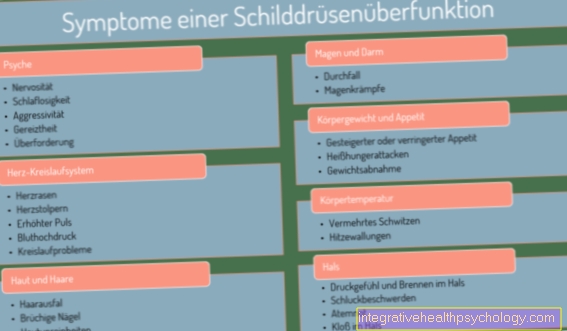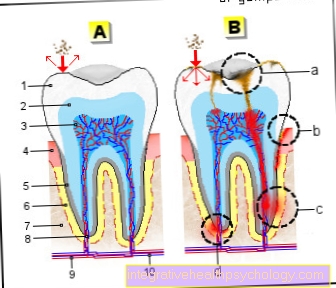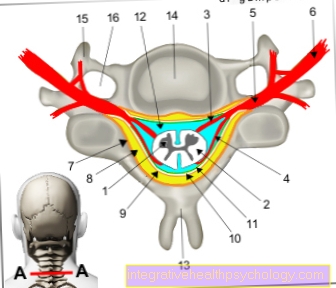Symptoms of tonsillitis
introduction
Tonsillitis (Tonsillar angina) is usually associated with fairly typical symptoms. Of course, the swollen, enlarged tonsils and pus on the tonsils are initially noticeable.
Read more about the topic here: Swollen tonsils
Depending on what is causing the inflammation and what stage it is at, the tonsils can also be either reddened, with small white spots (in this special case also called "stipple") or large, whitish deposits.
The first symptom that most patients experience discomfort is pain. These mainly occur when an affected person swallows or opens their mouth wide, for example when yawning. Usually the symptom / pain of tonsillitis is easy to localize, but sometimes it can radiate, preferably into the ears. Because of the inflammation, lymph nodes are also often swollen, especially those in the corner of the jaw.

These knots are movable and can also cause pain! Patients often find it difficult to swallow because of the enlarged tonsils and lymph nodes. In addition, there are general symptoms such as fatigue, languor and Exhaustion, Performance degradation, but also a headache or even fever can be associated with tonsillitis. In some cases, the voice sounds heavy or complains about a bitter aftertaste after ingestion, and in some cases there is also increased salivation.
This is to be distinguished from chronic tonsillitisin which all of the acute symptoms mentioned above are often absent. It is more characterized by general symptoms such as fatigue and Poor concentration. Difficulty swallowing is less pronounced, but what often occurs is a bad taste in the mouth and Bad breath. The Lymph nodes are permanently swollen here without pain. On the basis of a chronic tonsillitis, acute tonsillitis can of course break out again and again, which then also bring the typical complaints.
Important differential diagnoses of tonsillitis, as they are associated with the same or at least very similar symptoms, are above all the Scarlet fever, the Pfeiffer's glandular fever (Mononucleosis), one through Herpes viruses induced inflammation and the diphtheria. These all require different ones Treatments and should therefore always be clarified if there is a suspicion of tonsillitis.
Figure tonsillitis

A - tonsillitis - Tonsilitis
B - Simple catharrhal angina -
Angina catarrhalis
C - throat findings in diphtheria
D - ulcers in bacterial
Forms of angina
- Palatine almond bay -
Tonsillar fossa - Hard palate -
Palatum durum - Posterior palatal arch -
Arcus palatopharyngeus - Anterior palatal arch -
Arcus palatoglossus - Palatine almond -
Palatine tonsil - Back of tongue -
Dorsum linguae - Uvula + soft palate
(Soft palate) -
Uvula palatina + palatum molle - Meandering -
Isthmus faucium - Throat (back wall) -
Pharynx
You can find an overview of all Dr-Gumpert images at: medical illustrations
Symptoms of tonsillitis in toddlers
In addition to these symptoms typical in adults, there are some peculiarities in toddlers. The swelling of the Almonds can be problematic here because it is the Affect breathing can. This is due to the more generous anatomical proportions in adults less the case. An important first indication of a for the adult Tonsillitis with the toddler it is Refusal to eat or drink. It can also be a symptom in a toddler flushed face be with a recessed mouth area.
More signs of tonsillitis
Further Signs of tonsillitis are primarily:
- the tonsils are often reddened and swollen
- difficulties swallowing
- Difficulty breathing
- lumpy language
- Suppuration on the tonsils
- Mucosal defects on the tonsils
- swollen, pressure-sensitive, accessible lymph nodes in the neck and lower jaw area
- Bad breath (caused by the mostly bacterial colonization of the almonds)
For more information on other signs, see our topic: Signs of tonsillitis
Relieve tonsillitis
At the beginning of the onset of symptoms there are some measures to take in both toddlers and adults to alleviate. First of all it is important enough to drinkwhich is often neglected because of the difficulty swallowing. Above all, have a soothing effect Sage or chamomile teas, the anti-inflammatory and analgesic properties to have. Aloe vera juice also helps relieve symptoms, Honey has a calming effect. As a tried and tested means over-the-counter lozenges with a small proportion of anesthetic agent the Sore throat alleviate.
Especially in toddlers who have tonsillitis due to the less well-trained immune system should occur particularly often pain relieving measures taken, as toddlers are otherwise often the most important thing Neglect drinking. The symptom fever you can go through Calf wrap relieve, especially an effective remedy for toddlers. Warming neck wrap with quark are designed to remove toxins from the skin. The blood circulation promoted by the heat supports the immune system. However, it also helps with a sore throat to eat iceto relieve symptoms. During the time of tonsillitis one should Avoid acidic fruit juices or carbonated drinks, because this causes the Mucous membrane is additionally irritated. Symptoms in the child are best, however medically clarified immediately become.
Risk of contagion
One should be aware that when symptoms appear the person is contagious. A tonsillitis is one highly contagious disease and easily affects several people living in the area. Hence, one should in case of illness stay at homewhich often does not happen in adults. Work, especially in the office, should be avoided.
The same applies to the toddler Not going to kindergarten or elementary school.
The contagion occurs via so-called droplet infection. By Sneezing or coughing the smallest water droplets are blown into the surrounding air, in which the ones coming from the throat are Pathogens of tonsillitis. It is contagious when someone else inhales it. However, if you are exposed to a bacterial pathogen, you are one antibiotic has been prescribed 24 hours after starting taking usually no longer contagious.
Signs of chronic tonsillitis
The Type and severity of symptoms however differs in one acute and chronic tonsillitis.
If the inflammation is chronic, symptoms occur in a greatly weakened form on. The tonsillitis is called chronic if it longer than 3 months exists or acute inflammation occurs several times a year. The chronic expression is making itself felt mostly noticeable indirectly an increased susceptibility to infection and a general feeling of weakness. Slight sore throat and swelling Lymph nodes can appear as symptoms. In many cases, a bad taste is perceived in the mouth, too Bad breathwho through Brush teeth can only be alleviated in the short term, the sole abnormality may indicate chronic tonsillitis.
So can the diagnosis in the chronic variant because of unspecific symptoms Take some time, often the crucial therapy is that surgical removal of the tonsils. The acute tonsillitis however, it is in the entirety of the symptoms easy to recognize and heals under Antibiotic therapy good.














.jpg)














